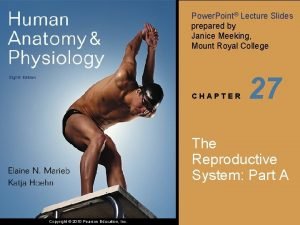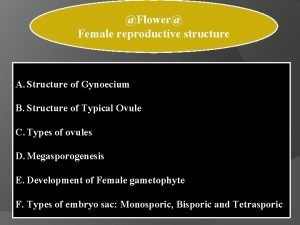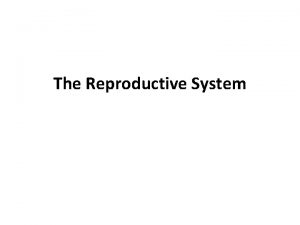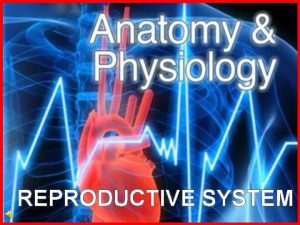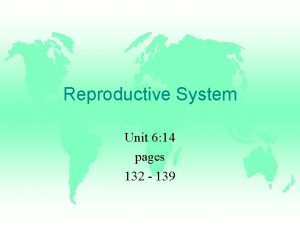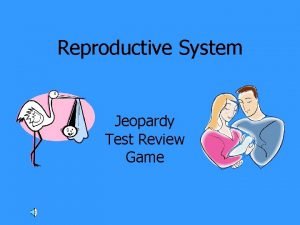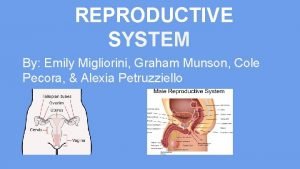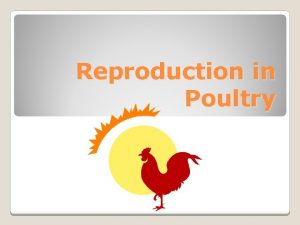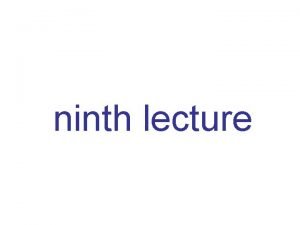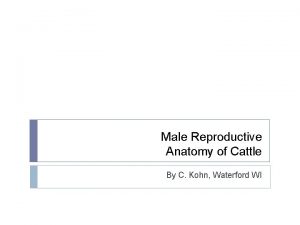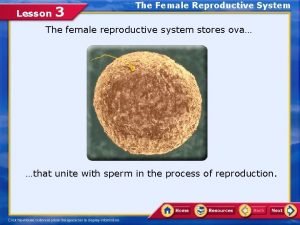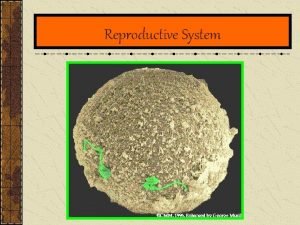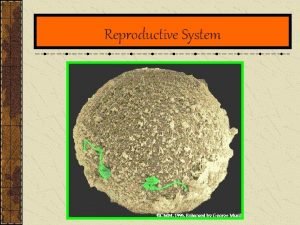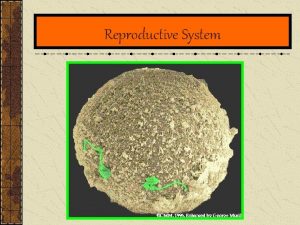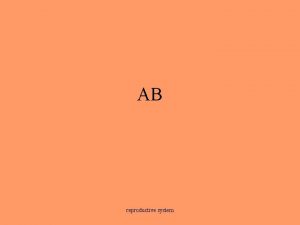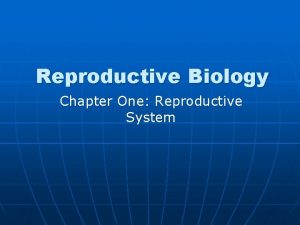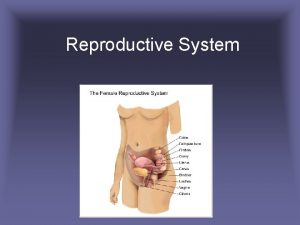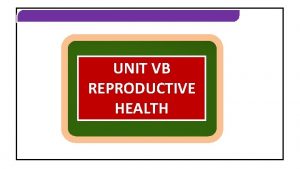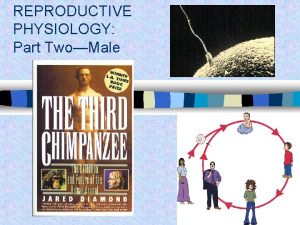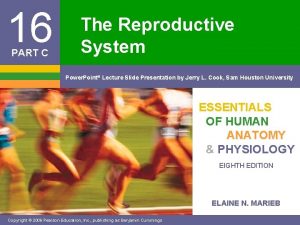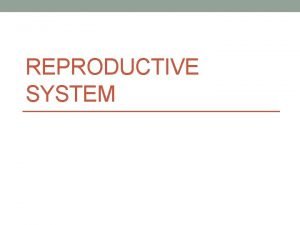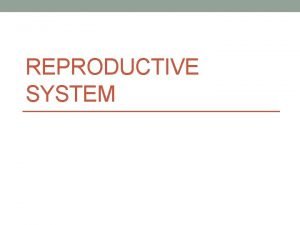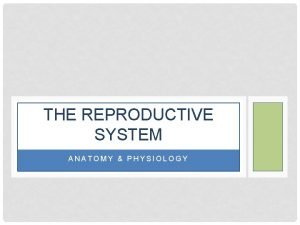16 PART A The Reproductive System Power Point































- Slides: 31

16 PART A The Reproductive System Power. Point® Lecture Slide Presentation by Jerry L. Cook, Sam Houston University ESSENTIALS OF HUMAN ANATOMY & PHYSIOLOGY EIGHTH EDITION ELAINE N. MARIEB Copyright © 2006 Pearson Education, Inc. , publishing as Benjamin Cummings

The Reproductive System § Gonads – primary sex organs § Testes in males § Ovaries in females § Gonads produce gametes (sex cells) and secrete hormones § Sperm – male gametes § Ova (eggs) – female gametes Copyright © 2006 Pearson Education, Inc. , publishing as Benjamin Cummings

Male Reproductive System § Testes § Duct system § Epididymis § Ductus deferens § Urethra PRESS TO PLAY MALE REPRODUCTIVE SYSTEM OVERVIEW ANIMATION Copyright © 2006 Pearson Education, Inc. , publishing as Benjamin Cummings Figure 16. 2 b

Male Reproductive System § Accessory organs § Seminal vesicle § Prostate gland § Bulbourethral gland § External genitalia § Penis § Scrotum Copyright © 2006 Pearson Education, Inc. , publishing as Benjamin Cummings

Male Reproductive System Figure 16. 2 a Copyright © 2006 Pearson Education, Inc. , publishing as Benjamin Cummings

Testes § Coverings of the testes § Tunica albuginea – capsule that surrounds each testis Figure 16. 1 Copyright © 2006 Pearson Education, Inc. , publishing as Benjamin Cummings

Testes § Coverings of the testes (continued) § Septa – extensions of the capsule that extend into the testis and divide it into lobules Figure 16. 1 Copyright © 2006 Pearson Education, Inc. , publishing as Benjamin Cummings

Testes § Each lobule contains one to four seminiferous tubules § Tightly coiled structures § Function as sperm-forming factories § Empty sperm into the rete testis § Sperm travels through the rete testis to the epididymis § Interstitial cells produce androgens such as testosterone Copyright © 2006 Pearson Education, Inc. , publishing as Benjamin Cummings

Epididymis § Comma-shaped, tightly coiled tube § Found on the superior part of the testis and along the posterior lateral side § Functions to mature and store sperm cells (at least 20 days) § Expels sperm with the contraction of muscles in the epididymis walls to the vas deferens Copyright © 2006 Pearson Education, Inc. , publishing as Benjamin Cummings

Ductus Deferens (Vas Deferens) § Carries sperm from the epididymis to the ejaculatory duct § Passes through the inguinal canal and over the bladder § Moves sperm by peristalsis § Spermatic cord – ductus deferens, blood vessels, and nerves in a connective tissue sheath Copyright © 2006 Pearson Education, Inc. , publishing as Benjamin Cummings

Ductus Deferens (Vas Deferens) § Ends in the ejaculatory duct which unites with the urethra § Vasectomy – cutting of the ductus deferens at the level of the testes to prevent transportation of sperm Copyright © 2006 Pearson Education, Inc. , publishing as Benjamin Cummings

Urethra § Extends from the base of the urinary bladder to the tip of the penis § Carries both urine and sperm § Sperm enters from the ejaculatory duct Copyright © 2006 Pearson Education, Inc. , publishing as Benjamin Cummings

Urethra § Regions of the urethra § Prostatic urethra –surrounded by prostate § Membranous urethra – from prostatic urethra to penis § Spongy (penile) urethra – runs the length of the penis Copyright © 2006 Pearson Education, Inc. , publishing as Benjamin Cummings

Seminal Vesicles § Located at the base of the bladder § Produces a thick, yellowish secretion (60% of semen) § Fructose (sugar) § Vitamin C § Prostaglandins § Other substances that nourish and activate sperm Copyright © 2006 Pearson Education, Inc. , publishing as Benjamin Cummings

Prostate Gland § Encircles the upper part of the urethra § Secretes a milky fluid § Helps to activate sperm § Enters the urethra through several small ducts Copyright © 2006 Pearson Education, Inc. , publishing as Benjamin Cummings

Bulbourethral Glands § Pea-sized gland inferior to the prostate § Produces a thick, clear mucus § Cleanses the urethra of acidic urine § Serves as a lubricant during sexual intercourse § Secreted into the penile urethra Copyright © 2006 Pearson Education, Inc. , publishing as Benjamin Cummings

Semen § Mixture of sperm and accessory gland secretions § Four functions of accessory gland secretions: § Fructose provides energy for sperm cells § Alkalinity of semen helps neutralize the acidic environment of vagina § Semen inhibits bacterial multiplication § Elements of semen enhance sperm motility Copyright © 2006 Pearson Education, Inc. , publishing as Benjamin Cummings

Scrotum § Divided into a left and right compartment by a fibrous septum, each containing one testis § Maintains testes at 3°C lower than normal body temperature to protect sperm viability Copyright © 2006 Pearson Education, Inc. , publishing as Benjamin Cummings

Scrotum § The ‘Dartos’ and Cremaster muscles are associated with it. § The ‘Dartos’ is a thin layer of smooth muscle throughout the scrotum § The Cremaster muscle is a mixture of smooth and skeletal muscle associated with the internal abdominal oblique muscle. § Both muscles pull the testes close to the body wall upon exposure to cold and relaxes with warmth. Copyright © 2006 Pearson Education, Inc. , publishing as Benjamin Cummings

External Genitalia § Penis § Delivers sperm into the female reproductive tract § Regions of the penis § Shaft § Glans penis (enlarged tip) § Prepuce (foreskin) § Folded cuff of skin around proximal end § Often removed by circumcision Copyright © 2006 Pearson Education, Inc. , publishing as Benjamin Cummings

A cross section of the penis reveals three areas of spongy erectile tissue around the urethra. K – Corpus Spongiosum J – Corpora Cavernosa Copyright © 2006 Pearson Education, Inc. , publishing as Benjamin Cummings

A cross section of the penis reveals three areas of spongy erectile tissue around the urethra. Copyright © 2006 Pearson Education, Inc. , publishing as Benjamin Cummings

Spermatogenesis § Production of sperm cells § Begins at puberty and continues throughout life § Occurs in the seminiferous tubules Copyright © 2006 Pearson Education, Inc. , publishing as Benjamin Cummings

Processes of Spermatogenesis § Spermatogonia (stem cells) undergo rapid mitosis to produce more stem cells before puberty § Follicle stimulating hormone (FSH) modifies spermatogonia division § One cell produced is a stem cell § The other cell produced becomes a primary spermatocyte Copyright © 2006 Pearson Education, Inc. , publishing as Benjamin Cummings

Processes of Spermatogenesis § Primary spermatocytes undergo meiosis § Haploid spermatids are produced § Sertoli Cells – supply sperm cells with nutrients Copyright © 2006 Pearson Education, Inc. , publishing as Benjamin Cummings

Processes of Spermatogenesis § Spermiogenesis § Late spermatids are produced with distinct regions § Head – contains DNA covered by the acrosome § Midpiece § Tail § Sperm cells result after maturing of spermatids § Spermatogenesis takes 64 to 72 days Copyright © 2006 Pearson Education, Inc. , publishing as Benjamin Cummings

Processes of Spermatogenesis Figure 16. 3 Copyright © 2006 Pearson Education, Inc. , publishing as Benjamin Cummings

Anatomy of a Mature Sperm Cell § The only human flagellated cell § DNA is found in the head Figure 16. 5 b Copyright © 2006 Pearson Education, Inc. , publishing as Benjamin Cummings

Testosterone Production § The most important hormone of the testes § Produced in interstitial cells Copyright © 2006 Pearson Education, Inc. , publishing as Benjamin Cummings

Testosterone Production § Functions of testosterone § Stimulates reproductive organ development § Underlies sex drive § Causes secondary sex characteristics § Deepening of voice § Increased hair growth § Enlargement of skeletal muscles § Thickening of bones Copyright © 2006 Pearson Education, Inc. , publishing as Benjamin Cummings

Regulation of Male Androgens (Sex Hormones) Figure 16. 6 Copyright © 2006 Pearson Education, Inc. , publishing as Benjamin Cummings
 Art-labeling activity: the male reproductive system, part 1
Art-labeling activity: the male reproductive system, part 1 Vesicular (graafian) follicle
Vesicular (graafian) follicle Endocrine system and reproductive system
Endocrine system and reproductive system Power triangle diagram
Power triangle diagram Informsu
Informsu Point point power
Point point power Compylotropous ovules are found in
Compylotropous ovules are found in Power angle curve in power system stability
Power angle curve in power system stability Function of the vagina
Function of the vagina Examination of reproductive system
Examination of reproductive system Drawing of the male and female reproductive system
Drawing of the male and female reproductive system Fetus reproductive system
Fetus reproductive system Chapter 16 the reproductive system
Chapter 16 the reproductive system Exercise 42 review male reproductive system
Exercise 42 review male reproductive system Female anatomy diagram
Female anatomy diagram Uterus layers histology
Uterus layers histology Female reproductive system pregnancy
Female reproductive system pregnancy Epidiymitis
Epidiymitis Female anatomy
Female anatomy Reproductive system jeopardy
Reproductive system jeopardy What is reproductive system
What is reproductive system Figure 16-1 male reproductive system
Figure 16-1 male reproductive system Graham munson
Graham munson Luteinizing hormone in male reproductive system
Luteinizing hormone in male reproductive system Poultry reproductive system
Poultry reproductive system Male reproductive system in plants
Male reproductive system in plants Chicken uterus
Chicken uterus Male reproductive system information
Male reproductive system information Where semen is stored
Where semen is stored Male cow reproductive system diagram
Male cow reproductive system diagram Male genital anatomy front view
Male genital anatomy front view Lesson 3 the female reproductive system
Lesson 3 the female reproductive system
